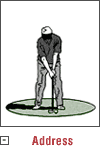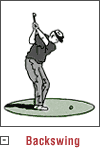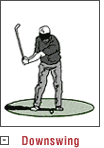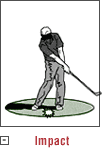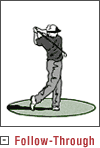How does the golf swing contribute to golf-related injuries? In medical school, the first thing they teach you is anatomy (Actually, the very first thing they teach you is that all bleeding stops - eventually!). The idea here is that it helps to know how things are supposed to be put together before you can figure out what’s wrong. We will look at human anatomy later when we review specific types of injuries. Here, let’s take a few minutes to look at the "anatomy", or phases, of the golf swing.
Golf instructors and golf medicine experts divide the swing into phases. Each phase of the swing (the Address, Backswing, Downswing, Impact, and Follow-Through) places demands on certain parts of the body and can result in specific types of injuries.
Injuries to body tissues during the golf swing are caused by excessive tissue tension, twisting, or the stress absorbed by the golfer due to impact of the club with the ball, or, ground, or rock, or - whatever.
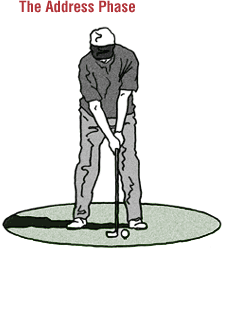 | To properly prepare for the golf swing, you must first "address" the ball. This is the part of the golf swing where you tip your hat and in your best Ed Norton drawl say, "Hellooo ball." It works every time.
The address is the least stressful golf swing phase (unless, of course, you happen to be playing with a big guy named Ralph).
During the address phase, body weight is evenly distributed on both feet, which should be roughly shoulder-width apart. The spine is tilted forward from the hips so that the spine is positioned at a right angle (90 degrees) to the club shaft. The knees are then relaxed (flexed) to center the body weight over the feet. The arms are extended and relaxed.
The address phase is not particularly stressful in itself, but mistakes in grip or stance can lead to injury-causing consequences later in the swing.
| 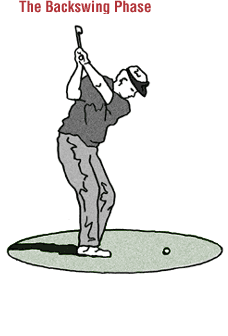 | During the backswing, the club is raised to its highest point in the swing. Body weight is shifted to the right foot. Rotation of the hips, knees, shoulders, and spine occur, and the head remains relatively still. At the top of the backswing the left thumb, left wrist, and right wrist are in the cocked position, and the forearm muscles are stretched as far as they can be.
Repetition and swing technique flaws during the backswing can lead to numerous problems, including: - Wrist/thumb tendonitis
- Aggravation of wrist/thumb arthritis
- Wrist "impaction" syndrome
- Nerve injuries of the wrist
- Elbow tendonitis (tennis elbow, golfer’s elbow)
- Shoulder impingement syndrome
- Spine (especially lower back) injury
Less than one in four golf injuries are thought to occur during the backswing phase.
| 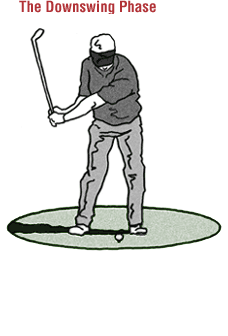 | During the downswing, the weight is shifted to the left foot while the knees, hips, and trunk rotate together to the left. A left-sided "uncoiling" occurs due to vigorous contraction of the abdominal muscles (the muscles responsible for rotating the trunk) and the spinal muscles. The abdominal muscles are working three times harder during the downswing phase than during the backswing.
Similarly, the spinal muscles are working four to five times harder during the downswing, compared with the backswing. The right shoulder muscles (rotator cuff) and right pectoral muscles (“pecs”) are also firing away. The pecs are now working six to seven times harder than they were during the backswing, in order to propel the club head (which accelerates to speeds of 100 miles per hour in about two-tenths of a second).
Repetition and swing technique flaws during the downswing can lead to numerous problems, including: - Wrist tendonitis/strain
- Elbow tendonitis/strain
- Stress fractures of the ribs
- Abdominal, pectoral, spinal, and shoulder muscle strain
Injuries during the downswing are about twice as frequent as backswing injuries.
| 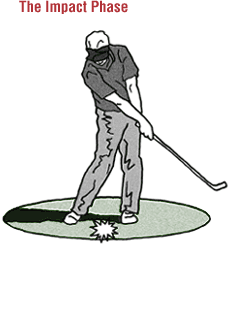 | At impact, the club makes contact with the ball - we hope. The wrists and hands complete the acceleration of the club head, the wrists unhinging in a whip-like motion as the right hand rotates over the left after the ball is hit. Body weight shifts to the left.
The force of impact from hitting the ball (called the counterforce) is transmitted up the club to the body. If an object other than the ball is struck by the club head (for example, the ground, a tree, a rock), the counterforce is greatly increased.
Many muscles act together to keep the club head moving forward through the impact phase, effectively overcoming the counterforce. Without these hardworking muscles (which include the forearms, and shoulder rotator cuff muscles), the club would screech to a halt at impact.
Repetition and swing technique flaws during impact can lead to numerous problems, including: - Wrist fracture (hamate bone)
- Nerve compression injury (carpal tunnel syndrome)
- Wrist/finger tendonitis (trigger finger)
- Elbow tendonitis (tennis elbow, golfer’s elbow)
- Shoulder (rotator cuff) strain/tear
- Aggravation of arthritis pain in the hip/knee
The majority of injuries related to the golf swing occur during the impact phase.
| 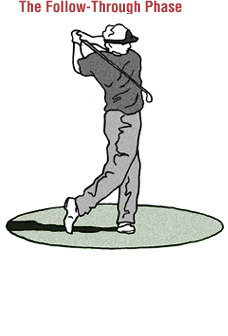 | After striking the ball, the club gradually decelerates during the follow-through. The body rotates to the left around the spine. The wrists rotate about each other to create the "roll-over" motion of the hands. The hips and shoulders continue to rotate until the body is facing the target (or, in my case, my body is facing the water hazard). The spine hyperextends, and body weight completely shifts to the left side.
Repetition and swing technique flaws during the follow-through can lead to numerous problems, including: - Spine hyperextension injury
- Knee sprain
- Ankle sprain
- Hip bursitis/tendonitis
About one in four golf swing injuries occur during the follow-through phase. Lower back injuries are especially common.
|
Click here to learn more about the book (table of contents, excerpts, ordering info...)
|






















